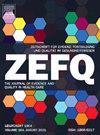Versorgungsqualität und -sicherheit nach Implantation eines Linksherzunterstützungssystems: eine qualitative Studie zur Patient*innenperspektive auf relevante Versorgungsaspekte
IF 1.4
Q4 HEALTH POLICY & SERVICES
Zeitschrift fur Evidenz Fortbildung und Qualitaet im Gesundheitswesen
Pub Date : 2024-09-01
DOI:10.1016/j.zefq.2024.07.001
引用次数: 0
Abstract
Introduction
Implantation of a left ventricular assist device (LVAD) requires extensive aftercare. It is largely unclear how aftercare should be designed from the patients’ perspective. Implications can be developed based on an examination of the healthcare context. Its main components are mapped on five tiers in the Human Factors of Home Health Care Model by Henriksen, Joseph, and Zayas-Caban (2009). Using this model, the present study explores the patient perspective on the context of healthcare after an LVAD implantation.
Methods
We employed a qualitative cross-sectional study, in which LVAD patients participated in semi-structured interviews. The transcribed interviews were analyzed using content analysis. First, relevant meaning units were identified and deductively categorized into the model. Then, categories of care-related aspects were developed inductively within each of the model tiers.
Results
We interviewed 18 patients aged 33 to 78 years who had been living with the LVAD between a few weeks and more than 10 years. Twenty-eight categories related to care aspects were developed within the model tiers: 3 categories on patient characteristics (e. g., self-management skills), 3 on caregiver characteristics (e. g., professionalism), 11 healthcare-related tasks and requirements (e. g., wound management), 8 on factors of the physical environment (e. g., controllability), medical devices and technologies (e. g., carrying systems for external components), and cultural, social and community environment (e. g., interaction with peers), as well as 3 on external environmental factors (e. g., healthcare infrastructure).
Discussion
The present study represents the first investigation focusing on aspects of the healthcare context influencing healthcare quality and safety from the perspective of LVAD patients in Germany. LVAD aftercare covers a broad and complex range of tasks. For this, patients, caregivers and healthcare professionals need specific knowledge, which is lacking in various respects. In the first place, this is compensated by the patients’ own initiative and the personal care provided by the VAD outpatient clinics.
Conclusion
Three key recommendations to optimize aftercare from the patient perspective are derived: Patients would benefit from a more flexible and decentralized aftercare concept, to which telemedicine could contribute. LVAD-specific expertise among general healthcare providers is perceived as insufficient by patients and could be strengthened through training and counseling services. The broad scope of tasks and the high level of responsibilities in LVAD aftercare pose challenges for patients and their families, which could be addressed through continuous information and training programs.
[从患者角度看左心室辅助装置治疗的医疗质量和安全:关于护理相关方面的定性研究]。
导言:左心室辅助装置(LVAD)的植入需要大量的术后护理。从患者的角度来看,目前还不清楚应该如何设计术后护理。我们可以根据对医疗环境的考察来制定相关方案。在 Henriksen、Joseph 和 Zayas-Caban(2009 年)所著的 "家庭医疗护理人因模型"(Human Factors of Home Health Care Model)中,家庭医疗护理的主要组成部分被划分为五个层次。本研究利用这一模型,从患者的角度探讨了植入 LVAD 后的医疗环境:我们采用了定性横断面研究,LVAD 患者参与了半结构化访谈。我们采用内容分析法对转录的访谈内容进行了分析。首先,确定相关的意义单元,并将其演绎归类到模型中。然后,在每个模型层中归纳出护理相关方面的类别:我们采访了 18 名年龄在 33 岁至 78 岁之间的患者,他们使用 LVAD 的时间从几周到超过 10 年不等。在各模型层级中,共制定了 28 个与护理相关的类别:3个类别涉及患者特征(如自我管理技能),3个类别涉及护理人员特征(如专业性),11个类别涉及医疗相关任务和要求(如伤口管理),8个类别涉及物理环境因素(如可控性)、医疗设备和技术(如外部组件的携带系统)、文化、社会和社区环境(如与同伴的互动),以及3个类别涉及外部环境因素(如医疗基础设施):本研究是首次从德国 LVAD 患者的角度出发,对影响医疗质量和安全的医疗环境方面进行的调查。LVAD 术后护理涉及广泛而复杂的任务。为此,患者、护理人员和医疗保健专业人员需要专门的知识,而这些知识在各方面都很缺乏。首先,患者自身的主动性和 VAD 门诊提供的个人护理弥补了这一不足:结论:从患者角度出发,提出了优化术后护理的三大建议:患者将从更加灵活和分散的术后护理理念中获益,而远程医疗可以为此做出贡献。患者认为普通医疗服务提供者在 LVAD 方面的专业知识不足,可以通过培训和咨询服务来加强。LVAD 术后护理的任务范围广、责任重大,这给患者及其家属带来了挑战,可以通过持续的信息和培训计划来解决。
本文章由计算机程序翻译,如有差异,请以英文原文为准。
求助全文
约1分钟内获得全文
求助全文
来源期刊

Zeitschrift fur Evidenz Fortbildung und Qualitaet im Gesundheitswesen
HEALTH POLICY & SERVICES-
CiteScore
1.90
自引率
18.20%
发文量
129
 求助内容:
求助内容: 应助结果提醒方式:
应助结果提醒方式:


